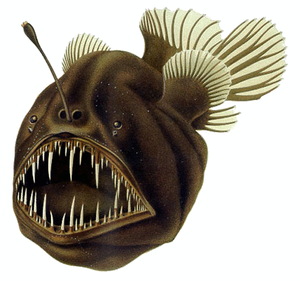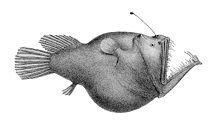Black angler
| Black angler | ||||||||||||
|---|---|---|---|---|---|---|---|---|---|---|---|---|

|
||||||||||||
| Systematics | ||||||||||||
|
||||||||||||
| Scientific name of the family | ||||||||||||
| Melanocetidae | ||||||||||||
| Gill , 1878 | ||||||||||||
| Scientific name of the genus | ||||||||||||
| Melanocetus | ||||||||||||
| Günther , 1864 |
The black angler or deep sea devil ( Melanocetus , Melanocetidae ( Gr .: Melanos = "black", cetus = "whale" or "sea monster")) are small deep sea fish that live in tropical to temperate zones of the Atlantic , Pacific and Indian Oceans worldwide . One species is only known from the Antarctic Ross Sea .
Appearance
Female black anglers grow to be 11 to 18 centimeters long. They have a soft, mostly scaly body that is black to dark brown in color, a large head with small eyes and a large mouth that is only equipped with long, dagger-like teeth in females. The jaw cannot be extended (not protractile). The olfactory bulb is simply built. A muscular "angel" (Illicium) formed from the first hard ray of the dorsal fin is sometimes present.
Fin formula : dorsal 12–17, anal 3–4.
Ventral fins are missing.
There is a strong sexual dimorphism among black anglers . While females can reach a length of 11 to 18 centimeters, the males are degenerate and stay at lengths below three centimeters. Your skin is prickly. However, they are not parasitic dwarf males , but move freely and feed on their own. Copepods were mainly found in their stomachs .
Like many deep-sea fish, black anglers have luminous organs . The bioluminescence is bacteria from the family Vibrionaceae produced. In a specimen of Melanocetus johnsonii that lived on for a few minutes after being caught, the esca (the “bait” on the “fishing rod”) glowed in a bright golden orange. During one minute, the light was “switched on” and “switched off” four to five times by sliding a dark pigmented skin of the Esca over it and then pulling it back again.
nutrition
The females use their luminous organs to lure their prey consisting of small crabs, lantern fish and bristle mouths . Their very elastic stomachs allow them to devour prey that is larger than themselves.
species
- Melanocetus eustalus Pietsch & Van Duzer, 1980.
- Melanocetus johnsonii Günther , 1864.
- Melanocetus murrayi Günther, 1887.
- Melanocetus niger Regan , 1925.
- Melanocetus polyactis Regan, 1925
- Melanocetus rossi Balushkin & Fedorov, 1981.
literature
- Kurt Fiedler: Textbook of Special Zoology, Volume II, Part 2: Fish . Gustav Fischer Verlag Jena, 1991, ISBN 3-334-00339-6
Individual evidence
- ↑ Melanocetus rossi on Fishbase.org (English)
Web links
- Black angler on Fishbase.org (English)
- Pietsch, Theodore W. 2005. Melanocetidae. Melanocetus. Black Seadevils. Version 05 November 2005 (under construction). in The Tree of Life Web Project
- Marine Biologists Capture Footage of Rare Black Seadevil Anglerfish
